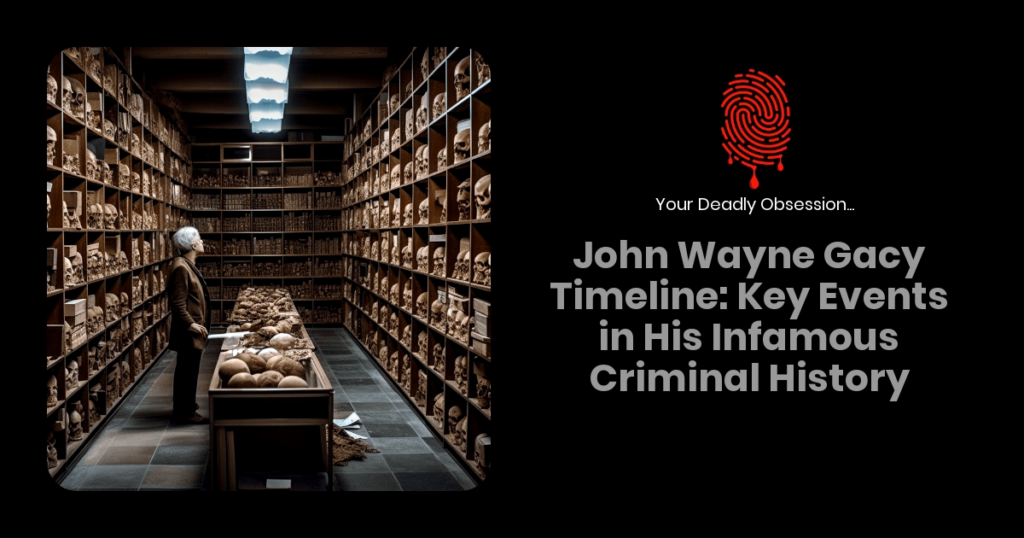In the realms of American true crime, few cases have captured the public’s imagination quite like that of John Wayne Gacy. Known as the “Killer Clown,” Gacy’s heinous acts during the 1970s left a dark stain on history, and understanding the timeline of events can provide a valuable insight into the twisted mind of this notorious serial killer.

The life and crimes of John Wayne Gacy were marked by a series of chilling milestones, each closer to the horrifying apex of his criminal career. From his early life struggles to the harrowing discoveries made after his arrest, the Gacy timeline is a twisted path of deception, violence, and seemingly inexplicable brutality. We’ll delve into the main events that form the backbone of this grisly chronology, seeking to understand the motivations and actions of the man behind the clown makeup.
As we delve deeper into the John Wayne Gacy timeline, we’ll uncover the key moments that shaped this notorious figure. From the killer’s formative years to the escalation of his criminal activities, each incident adds another layer to the complex and chilling puzzle of one of America’s most infamous serial killers. Join us as we piece together the tragic and terrifying story of the man who haunted the nation with his unspeakable deeds.
Childhood and Early Life
John Wayne Gacy, a notorious serial killer with a shocking history, had an upbringing that many have studied in the hopes of uncovering the roots of his terrifying actions. In this section, we’ll dive into Gacy’s childhood and early life, touching upon key events that may have shaped him into the gruesome individual he would later become.
Born on March 17, 1942, in Chicago, Illinois, Gacy was the second of three children raised by his parents, John Stanley Gacy and Marion Elaine Robinson. Raised in a Catholic household, Gacy’s upbringing turned out to be anything but idyllic. His father, an abusive alcoholic, often subjected Gacy and his siblings to physical and psychological violence.
As a youngster, Gacy had several health problems. He was overweight and had a congenital heart condition. Consequently, he faced frequent ridicule from his peers and continuous criticism from his father. Despite this, Gacy strived to make his father proud, but it seemed to be an unattainable goal.
Gacy’s school years were marked by even more difficulties. He attended four different high schools but was never able to graduate. Additionally, due to his heart condition, he was restricted from participating in sports. Gacy’s adolescence was also marked by a series of events that would later be seen as significant milestones in his troubling development:
- At the age of 18, Gacy was arrested for sexual misconduct involving a teenage boy. The charges were later dropped when the victim failed to appear in court.
- In 1964, Gacy married his first wife, Marilyn Myers, and moved to Waterloo, Iowa, where he managed a restaurant. The couple later had two children.
- While living in Waterloo, Gacy became involved in various local organizations, including the Jaycees. He was well-respected and even elected as the organization’s vice president.
Gacy’s early life in Waterloo appeared promising, but his dark side would soon emerge. He began hosting secret parties involving illegal drugs, prostitution, and pornographic movies. This revealed a dual nature, in which Gacy maintained a respectable persona in public while hiding his deviant behavior behind closed doors.
In 1968, Gacy was convicted of sodomy and sentenced to 10 years in prison. He was released on parole in 1970, only serving 18 months of his sentence. This event marked a turning point in Gacy’s life, setting him further down the murderous path for which he would become infamous.
The Transformation Years
During the transformation years, John Wayne Gacy went through significant changes in his life, transforming from a seemingly normal individual to a notorious serial killer. As die-hard fans of cold cases, crime, and mystery, let’s take a closer look at the key events in Gacy’s life that occurred during these years.
Early in his life, Gacy had a troubled relationship with his father, who physically and verbally abused him. Despite this, he managed to find some success in the working world. He became a successful manager at various fast-food restaurants and eventually started his own construction company. This period saw Gacy build a respectable life for himself, including getting married and having children.
In 1968, Gacy’s life took a dark turn when he was arrested and convicted for sexually assaulting two teenage boys. He was sentenced to 10 years in the Anamosa State Penitentiary. This marked the beginning of Gacy’s downward spiral.
| Year | Event |
|---|---|
| 1970 | Gacy’s wife filed for divorce, and he never saw his children again. |
| 1971 | Gacy was granted parole after serving only 18 months of his sentence. |
| 1972 | He married again and moved back to Chicago. |
Upon returning to Chicago, Gacy became involved in local politics and even dressed up as Pogo the Clown for children’s parties. In secret, he began his killing spree, targeting young men and boys. Gacy’s murders typically followed a chilling pattern:
- He would lure his victims to his home
- Subject them to horrific acts of sexual assault and torture
- Strangle them to death
His killing spree continued for six years, during which he is known to have killed at least 33 victims. Police began closing in on Gacy in 1978, and he was finally arrested in December of that year. His trial began in February 1980, where he was found guilty of 33 counts of murder and sentenced to death. Gacy was executed by lethal injection in 1994.
The transformation years of John Wayne Gacy’s life revealed a dark and twisted individual hiding behind a mask of normality. These years are a chilling reminder of the depths of human depravity and the importance of understanding the psychology of serial killers for the prevention and solving of such heinous crimes.
Grisly Discoveries: 1970s Murder Revelations
The 1970s murder revelations surrounding John Wayne Gacy caused shockwaves nationwide, presenting a gruesome tale of deceit and terror. As die-hard fans of cold cases and mystery, we can’t help but delve into the grisly discoveries made during this period.
In the early 1970s, Gacy appeared to be a respectable member of society, owning a successful construction business and becoming involved in community events. But behind this facade, he was hiding a dark secret. It wasn’t until 1978 when the truth finally began to surface, and John Wayne Gacy’s notorious killings were uncovered.
Several factors led authorities to Gacy’s doorstep:
- The disappearance of a young boy named Robert Piest in 1978
- A troubling criminal history, including a previous sodomy charge against Gacy in Iowa
- An investigation into Gacy’s employment of young boys, many of whom had gone missing
Following 24/7 surveillance on Gacy, the search of his home led to the devastating discovery of the bodies of several young men:
| Location | Number of Victims Found |
|---|---|
| Crawl space | 26 |
| Garage | 3 |
| Nearby River | 4 |
| Total | 33 |
Gacy’s modus operandi was alarmingly consistent: he would lure young men and boys to his home, gain their trust through conversation, then restrain and eventually murder them. It’s known that he would dress up as “Pogo the Clown” to further establish control over his victims.
- Some important dates from the timeline of events include:
- December 11, 1978: Robert Piest vanishes, initiating the investigation into Gacy
- December 21, 1978: First body discovered in Gacy’s crawl space
- January 9, 1979: Last body found in Des Plaines River
After the discovery of these atrocities, Gacy admitted to his crimes and was charged with 33 counts of murder. Though some have questioned his culpability, the evidence against him was staggering. Gacy’s house on Summerdale Avenue was destroyed in 1979, the grisly secrets it contained serving as a haunting reminder of the horrors that transpired within its walls.
Despite the passage of time, the chilling, unforgettable case of John Wayne Gacy continues to captivate and horrify fans of true crime, leaving a lasting impression on the collective psyche. The 1970s murder revelations stand as a testament to the macabre and disturbing underbelly of American society.

The Trial and Conviction
John Wayne Gacy’s trial started on February 6, 1980, with an overwhelming amount of evidence against him. During the trial, Gacy’s defense team attempted to plead insanity, but this strategy ultimately failed. Gacy was found guilty of thirty-three murders on March 13, 1980, making him one of the most prolific serial killers in U.S. history. Let’s delve deeper into the details surrounding Gacy’s trial and conviction.
The prosecution presented damning evidence against Gacy, including:
- Autopsies of his many victims, which revealed that they had been asphyxiated or strangled.
- Eyewitness testimony from those who had witnessed Gacy’s presence at the crime scenes or seen him with the victims.
- Gacy’s own confession to the police shortly before his arrest.
The defense team had an uphill battle, but they persisted in their attempts to prove Gacy’s insanity. They argued that his alter ego, known as Pogo the Clown, was responsible for the murders. The team also tried to raise doubt about Gacy’s confession, pointing to inconsistencies that could indicate it was falsified. Moreover, psychiatrists testified that he was suffering from a borderline personality disorder and had a history of psychosis.
However, the prosecution’s counterarguments ultimately sealed Gacy’s fate. Prosecution experts testified that Gacy was legally sane at the time of the crimes and knew what he was doing. They also pointed out the methodical nature of the murders, which contradicted the defense’s claim of insanity.
| Crime Data | Number/Example |
|---|---|
| Victims | 33+ |
| Trial Start | 02/06/1980 |
| Conviction Date | 03/13/1980 |
Following a tumultuous trial, the jury deliberated for just two hours before finding Gacy guilty of all charges. He was sentenced to death and ultimately executed by lethal injection on May 10, 1994.
Numerous documentaries, movies, and books have been created about John Wayne Gacy’s heinous crimes, the ensuing trial, and his chilling persona as a killer clown. These works continue to fascinate true crime enthusiasts and contribute to the dark mystique surrounding Gacy’s twisted story.
Conclusion
Throughout our examination of the John Wayne Gacy timeline, we’ve delved deep into the chilling details of his life, crimes, and eventual capture. As die-hard fans of cold cases, crime, and mystery, we can’t help but feel a sense of intrigue and fascination when exploring Gacy’s story. Through our analysis, we’ve unraveled key moments in this infamous serial killer’s life, providing a comprehensive and grim understanding of the events leading to his demise.
We have looked into Gacy’s early life, revealing alarming instances of abuse and behavioral issues, which may have contributed to his dark and twisted psyche. Our journey took us through his criminal career, highlighting the heinous nature of his actions, as he murdered and sexually assaulted numerous young men and boys.
Our examination explored Gacy’s capture, trial, and eventual execution, offering insight into the role that forensic evidence and detective work played in bringing this monstrous individual to justice. The chilling facts and grim statistics about his crime spree have left an indelible mark on the history of American serial killers.
The John Wayne Gacy timeline serves as a stark reminder that evil can lurk in the most unsuspecting of places. In our pursuit of understanding the complex and twisted realm of cold cases and criminal mysteries, we must continue to explore these dark corners of humanity to not only satisfy our curiosity but also to learn from these harrowing events.
By delving into these intricate crime stories, we can examine the psychology and motives of the perpetrators, ultimately aiding in the prevention of similar tragedies in the future. As we continue to expand our knowledge on this macabre subject, our unwavering interest in these cases allows us to grow as dedicated and passionate followers of crime and mystery.
References:

Owner & entrepreneur with a passion for murder mystery! Seriously, who doesn’t love murder mystery?
Chris is a proud member of the American Medical Writer’s Association (AMWA), the International Society for Medical Publication Professionals (ISMPP), the National Association of Science Writers (NASW), the Council of Science Editors, the Author’s Guild, and the Editorial Freelance Association (EFA).

